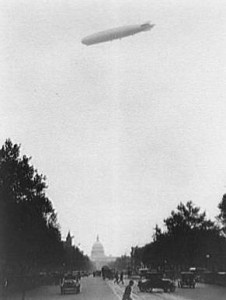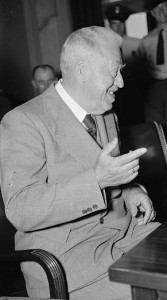
The Graf Zeppelin over the Capitol (Library of Congress)
On September 28, 1928, 127th Zeppelin took off from its factory in Germany. It was named Graf Zeppelin, in honor of the founder of the airship company, who had died about 10 years earlier. During the next nine years, the Graf Zeppelin travelled over one million miles and visited the US a total of five times. Graf Zeppelin thus became one of the most successful airships of all time.
In this edition of Lost Capitol Hill, I want to focus on one particular episode in the airship’s storied career
On 15 October 1928, Graf Zeppelin passed over Washington, D.C. She was 105 hours into the first trans-Atlantic passenger flight, a duration that was only a few hours short of the record for airships at the time. The flight had not been entirely trouble-free, as it was necessary for riggers to climb out on the outside of the ship to repair storm damage midway across the Atlantic. In spite of this, the captain, Hugo Eckener, delayed the landing in New Jersey a little longer by having the ship circle over the Capitol. An AP article from Washington Post, Oct 26, 1928 described the scene thus:
Washington first saluted the Graf Zeppelin at 12:21 when she approached from the east over the Capitol. As she circled above the Government buildings, sharp-eyed naval experts noticed the hole in her port stabilizer – the rent that had caused the anxiety last Saturday.
The airship dipped its nose to the Capitol and then continued west, flying over the White House, where Calvin Coolidge, like so many other Washingtonians, stopped work and stepped outside to have a look. Later that afternoon, the passengers – including one stowaway – disembarked in Lakehurst, NJ. The crew of the Graf Zeppelin was given a ticker-tape parade in New York City and invited to the White House.
A year later, the Graf Zeppelin completed a round-the-world flight, and later flew to the North Pole twice, but she was mainly used for flights to and from South America.

Hugo Eckener testifying before congress, May 26, 1937 (Library of Congress)
On May 5, 1937, the Hindenburg burned in Lakehurst, making the future of hydrogen airships uncertain. Exactly three weeks later, Hugo Eckener returned to Capitol Hill – this time on the ground – to testify before the Senate Military Affairs Committee that the US was the only country that could use airships in war, as they were the only ones with sufficient supplies of helium. He furthermore asked that the US consider giving Germany access to helium for commercial purposes. Eckener was unsuccessful in this, and the Graf Zeppelin (which would probably not have worked with helium, anyway) was retired a few days later and was disassembled shortly after the outbreak of the Second World War.

Robert, great column. Very interesting. Keep it up.